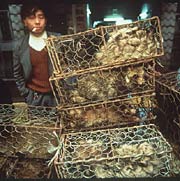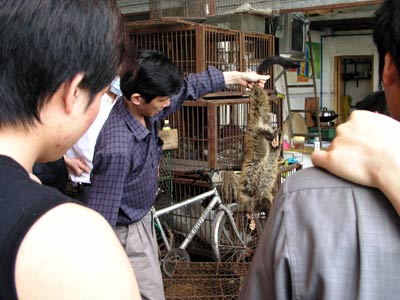
NGO in Special Consultative Status with the Economic and Social Council of the United Nations
 |
NGO in Special Consultative Status with the Economic and Social Council of the United Nations |
| The World Health Organization has criticised Chinese plans to slaughter 10,000 civet cats in an attempt to curb the spread of the deadly Sars virus. The news comes as the organisation said tests confirmed China's first case of the illness in six months. |
 Many researchers believe Sars could have jumped from animals to humans |
| But the WHO said the move was radical and that the man's case remains an isolated one which does not constitute a public health emergency. It also warned that not enough research had been conducted into possible links between the civet cat and Sars (Severe Acute Respiratory Syndrome). "At this point in time... without seeing that data, there is no conclusive evidence that civets are the animals that carry the Sars virus," WHO Sars team leader Judy Hall told the BBC. |
 Served in wild game restaurants Estimated 10,000 in Guangdong markets May have been the source of the virus which jumped to humans |

 |
The researchers found clear differences between the animal and human versions of the virus, but said they were minor enough to show that SARS jumped from animals, as influenza and other viruses have done. "It's a landmark discovery," said Kathryn Holmes of the University of Colorado Health Sciences Center, a leading expert on the coronavirus family that SARS belong to. |
| HONG KONG, China -- Scientists say antibodies found in workers who handled exotic animals at a food market in southern China supports their theory the SARS virus jumped from animals to humans. In a random study of ten market workers in Guangdong's capital of Shenzhen, researchers from the University of Hong Kong and the Shenzhen Disease Prevention and Control Center, found five were carrying SARS antibodies, disease-fighting chemicals that give evidence of infection. |
 Cats at a wild animal market in Guangdong. |
For a virulent virus seeking to jump from animals to humans China's Guangdong province may be the perfect habitat.
Along the highways, ubiquitous farms are lined up next to each other, with farmers tending their ducks, chickens, and pigs in teeming and cramped quarters. In the city's food stalls, meanwhile, vendors keep their meat—alive and dead—in cages and baskets stacked on top of each other. Customers can choose from a menu of rats, cats, dogs, frogs, snakes, and exotic birds. In such unhygienic conditions, scientists have long warned, it's just a matter of time before a hidden and potentially lethal virus would make the leap from animal to man. It should come as no surprise, then, that one virus—the enigmatic coronavirus that causes severe acute respiratory syndrome, or SARS—in all likelihood did. |
 Many wild and exotic animals are sold as food in China, such as these racoons in stacked cages at the Qingping Market in Guangzhou. Some scientists warn that such conditions are ideal for a virus to jump from animals to humans, which likely happened in the case of SARS. Photograph copyright Michael S. Yamashita |





